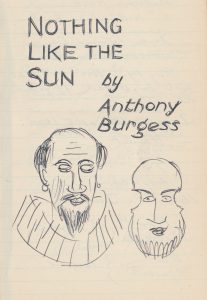Our latest exhibition, ‘Burgess and Shakespeare’, is now open and will be on show until early 2015.
Shakespeare was to Anthony Burgess both a great artist and a man with whom he could identify. The exhibition – drawing on the Burgess Foundation’s rich collection – explores the ways in which Burgess identified with Shakespeare and how Shakespeare is reflected in Burgess’s works.
Like many of his contemporaries, and students today throughout the world, John Burgess Wilson received his introduction to Shakespeare as part of his formal education. Burgess remained an avid reader and student of Shakespeare for the rest of his life; a fact reflected not only in the books Burgess collected, but also in the full range of his creative works, encompassing his literary, poetic, dramatic, musical, and journalistic writing.

Beginning with Burgess’s recollection of his first reading of Venus and Adonis as a fourteen year old student at the Xaverian College in Rusholme, the exhibition covers Burgess’s teaching career in the UK and beyond following his demobilisation from the army in 1946, to his later career as a professional writer. Items are on display from Burgess’s major Shakespeare-inspired works, such as Nothing Like the Sun: A Story of Shakespeare’s Love-life (1964), Shakespeare (1970) – his richly illustrated speculative biography -and Mr W.S.,A Ballet on the Career of William Shakespeare (1979); along with Burgess’s lesser-known works, such as his Shakespearean short-stories, and his involvement in abortive projects to produce a musical on the life of Shakespeare (The Bawdy Bard or Will!) during the late 1960s and a television series on Shakespeare’s life in 1973.
Burgess’s Shakespeare was, by his own admission, a reconstructed semi-fictional Shakespeare, taken from a variety of sources, including his own imagination. He made no apology for this and claimed the ‘right of every Shakespeare-lover who has ever lived to paint his own portrait of the man’. In the absence of firm historical fact, each age, ‘perhaps each decade’, could discover a new aspect of Shakespeare ‘and every new aspect of Shakespeare will be as true as any other’. The exhibition reveals some aspects of Burgess’s self-identification with Shakespeare and, in so doing, also reveals something of how Burgess characterised himself.
The exhibition is open daily on weekdays from 10am – 2pm and in the evenings during events.



